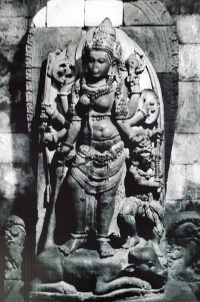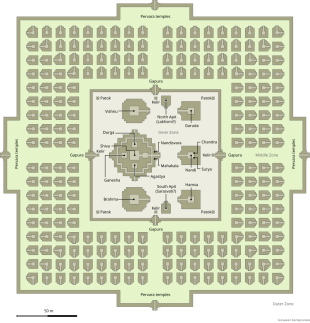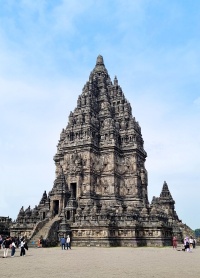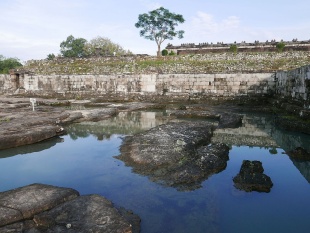PRAMBANAN TEMPLE
Prambanan Temple (15 kilometers east of Yogyakarta) is the largest and most beautiful Hindu temple in Indonesia.. Named after the village where it is located, it was built in the 9th century 50 years after Borubudur and is known locally as the Temple of the Slender Virgin (Roro Jonggrang).Prambanan contains many lavish decorations and sexually-suggestive sculptures, scenes from the Ramayan and motifs that mix Hindu and Buddhist symbols. It has eight shrines which lie among green fields and villages. Architecturally, it is sort of like Angkor Wat with a central artichoke-shaped stupa surrounded by four smaller ones.
The three main temples are dedicated to Hindu gods Shiva, Vishnu and Brahma. The biggest temple is dedicated to Shiva —the destroyer, and the two smaller ones which flank it on the east and west are dedicated to Brahma — the creator and Vishnu — the sustainer. The tallest temple of Prambanan—the main Shiva temple—is a staggering 47 meters (130 feet) high. Its peak is visible from far away and rises high above the ruins of the other temples.The temple across from the Shiva temple contains a fine image of a Nadi bull and the Lingga Batara Siwa stone, a symbol of fertility. . The main temple of Shiva houses the magnificent statue of a four-armed Shiva, standing on Buddhist-style lotus blossoms. In the northern cell is a fine image of Durga, Shiva’s consort. Some believe the Durga image is actually that of the Slender Virgin, who according to legend was turned to stone by a giant she refused to marry. The outsides are adorned with bas-reliefs depicting the Ramayana story.
Prambadan is surrounded by the ruins of 240 small “guard “ temples. Altogether there are 400 temples in the Prambadan area. Most are within five kilometers of Prambanan village and are generally not visited except by archeology nuts. But that is not to say they are not without merit. A good way to explore them is to rent a bicycle. The proximity of Prambanan and Buddhist Borobudur temple tells us that on Java, Buddhism and Hinduism lived peacefully next to one another.
From May to October at full moon, the classic Javanese Ramayana ballet or dance drama is performed by more than 250 dancers in an outdoor open stage with as its backdrop the full moon dramatically rising over the temples. The epic Ramayana tells the story of Prince Rama and his wife Sita who are wandering in the forest. When Rama sees a golden deer he chases it, but not before drawing a circle around Sita. He tells her not to step out of the circle to stay safe. The king of ogres Rahwana lures Sita out of the circle, abducts her and carries her to his kingdom, Alengka. The grief stricken Rama is assisted by the monkey king, Hanuman. who finds Sita in Rahwana’s palace. He burns Alengka and Sita is saved and restored to her husband.
See Separate Article: MATARAM KINGDOM: HISTORY, HINDUISM, PRAMBANAN factsanddetails.com
Architecture of Prambanan Temple
According to UNESCO: Prambanan Temple Compounds presents the grandiose culture of Siva art as a masterpiece of the classical period in Indonesia, and the region. The property is an outstanding religious complex, characteristic of Siva expression of the 10th century. Built in the 10th century, this is the largest temple compound dedicated to Shiva in Indonesia. Rising above the centre of the last of these concentric squares are three temples decorated with reliefs illustrating the epic of the Ramayana, dedicated to the three great Hindu divinities (Shiva, Vishnu and Brahma) and three temples dedicated to the animals who serve them. [Source: UNESCO]
Prambanan Temple Compounds consist of Prambanan Temple (also called Loro Jonggrang), Sewu Temple, Bubrah Temple and Lumbung Temple. Prambanan Temple itself is a complex consisting of 240 temples. All the mentioned temples form the Prambanan Archaeological Park and were built during the heyday of Sailendra’s powerful dynasty in Java in the 8th century AD. These compounds are located on the border between the two provinces of Yogyakarta and Central Java on Java Island.
Prambanan Temple Compounds comprises of two groups of buildings which includes Loro Jonggrang, Sewu complexes, Lumbung, Bubrah and Asu (Gana). The 508 stone temples of various shapes and sizes are either in a complete and preserved condition or have been retained as ruins.While Loro Jonggrang, dating from the 9th century, is a brilliant example of Hindu religious bas-reliefs, Sewu, with its four pairs of Dwarapala giant statues, is Indonesia’s largest Buddhist complex including the temples of Lumbung, Bubrah and Asu (Gana temple). The Hindu temples are decorated with reliefs illustrating the Indonesian version of the Ramayana epic which are masterpieces of stone carvings. These are surrounded by hundreds of shrines that have been arranged in three parts showing high levels of stone building technology and architecture from the 8th century AD in Java. With over 500 temples, Prambanan Temple Compounds represents not only an architectural and cultural treasure, but also a standing proof of past religious peaceful cohabitation.
Prambanan was designed as three concentric squares. In all there are 224 temples in the entire complex. The inner square contains 16 temples, the most significant being the 47 meters high central Siva temple flanked to the north by the Brahma temple and to the south by the Vishnu temple. These three ancient masterpieces of Hindu architecture are locally referred to as the Prambanan Temple or Lorojonggrang Temple (Slender Maiden); the compound was deserted soon after it was completed, possibly owing to the eruption of nearby Mount Merapi.
A square platform is divided into concentric courts by square-plane walls. In the middle of the last enceinte stand the temples dedicated to the three great Hindu gods and three small temples dedicated to their animal vehicles (Bull for Siva, Eagle for Brahma and Swan for Vishnu). Other minor temples were located at the entrance gates or outside the central enceinte (four ensembles).
The Siva temple had four statues: located in the centre chamber is the Siva statue; in the north chamber stands the Dewi Durga Mahisasuramardhini statue; in the west chamber stands the Ganesya statue; and the south chamber contains the statue of Agastya. Inside the Brahma temple there is Brahma statue, and in the Vishnu temple there is the Vishnu statue. In the Vishnu temple is carved the story of Kresnayana, while the Brahma temple houses the continuous story of the Ramayana. The temples of Siva, Vishnu and Brahma are decorated with reliefs illustrating the Ramayana period (history of the Hindu hero Rama, written around 300).
The neighbouring Buddhist ensemble at Sewu comprises a central temple surrounded by a multitude of minor temples. Surprisingly, it shares many design attributes with the Hindu Loro Joggrang Temple, perhaps indicating the degree to which such temples also reflect state policies and control. Three other temples in ruins set between Sewu and Loro Joggrang complete the ensemble around Prambanan: Lumbuna, Burah and Asu.
Prambanan and the Slender Virgin Legend

Prambanan is known locally as Roro Jonggrang, coming from the legend of the ‘slender virgin’. According to the legend once upon a time, there was a young and powerful giant named Bandung Bondowoso. He wanted to marry a beautiful princess named Roro Jonggrang. Her father, the king, agreed and forced her to marry Bandung Bondowoso. Roro Jonggrang did not love him yet could not refuse him.
After careful consideration, she thought of a way to refuse Bondowoso, whose magical power was well-known. She decided she would agree but only if Bondowoso built 1,000 temples in one night before the break of dawn. She insisted that the work must be completed before the rooster crowed, something she believed was impossible. But with the help of genies and his own magical powers, Bondowoso managed to complete 999 temples.
Panicked, Jonggrang told the women of her village to start pounding rice so that the rooster would wake up and begin to crow. When Bondowoso heard this he was deeply disappointed and wildly enraged. When he found out that Roro Jonggrang had made the roosters crow, he turned her into stone, The statue of a slender virgin graces the main Prambanan temple, while a group of temples nearby is called the Candi Sewu or the Thousand Temples.
Restoration of Prambanan Temple
After hundreds of years of neglect, the Prambanan temple was rediscovered by CA Lons, a Dutchman, in 1733. Since then, this temple has been cleared of dirt and jungle and restored so the structures look like they did in the 10th century.
Prambanan Temple Compounds contains the original structures that were built in the 9th century AD. The temples collapsed due to earthquake, volcanic eruption and a shift of political power in the early 11th century. These compounds have never been displaced or changed. Restoration works have been conducted since 1918, both in original traditional method of interlocking stone and modern methods using concrete to strengthen the temple structure. Even though extensive restoration works have been done in the past and as recently as after the 2006 earthquake, great care has been taken to retain the authenticity of the structures.
The temple was damaged during the May 2006 Java earthquake. Early photos suggested that although the complex was structurally intact, the damage was significant. Large pieces of debris, including carvings, were scattered over the ground. The temple was closed to visitors until the damage could be fully assessed. Eventually, the head of Yogyakarta Archaeological Conservation Agency stated that it would take months to identify the full extent of the damage. Some weeks later in 2006, the site was re-opened for visitors.
Visiting of Prambanan Temple
Many tourists visit Prambanan Temple as part of a full day or half day tour of Borobodur. During full moon evenings in the months from May to October the Ramayana ballet is performed in an open air theater on the southern side of the temple. While is no formal dress code at Prambanan temple, this is a holy site so it is advised the visitors dress modestly. In 2008, 856,029 Indonesian visitors and 114,951 foreign visitors visited Prambanan. In 6 January 2009 the reconstruction of Nandi temple finished. As of 2009, the interior of most of the temples remains off-limits for safety reasons.
In 2014, major tourist attractions in Yogyakarta and Central Java, including Borobudur, Prambanan and Ratu Boko, were closed from visitors, after being severely affected by the volcanic ashes from the eruption of Kelud volcano in East Java, located around 200 kilometers east from Yogyakarta. The Kelud volcano erupted on 13 February 2014 with explosion heard as far away as Yogyakarta.Four years earlier, Prambanan was spared from Merapi volcanic ash and eruption in 2010 since the wind and ashfall were directed westward and affected Borobudur instead.
Susan Spano wrote in the Los Angeles Times: “The compound, seriously damaged in 2006 by a 6.3-magnitude earthquake and partly covered by shaky bamboo scaffolding, looks as though it could collapse with the next tremor.
“Noor said, "Hati hati," which means "be careful" in Indonesian, then waited while I climbed the main stupa and paid my respects to a 10-foot-tall statue of the Hindu god Shiva. Together with Buddhist Borobudur, this chiefly Hindu place of worship is a testament to the theological melding that took place in the Middle Ages on Java. The two faiths borrowed from each other until Islam, brought by Arab traders, took root around 1400. [Source: Susan Spano, Los Angeles Times, January 6, 2012]
In 2014, one traveler posted: “After paying the hefty foreigners’ admission to Prambanan, the visitor walks toward the temple only to discover that it’s closed for repairs. One can see it from a distance, but a fence blocks a closer look. The park setting is lovely, and other temples within the area may be visited. But tourists need to be warned — as no signage tells one until after the admission has been paid — that the Prambanan temple is closed.”
Visitors to Prambanan wander around the temples on foot. This temple compound covers 39.8 hectares. In the main yard, there are the three main temples, as well as three Wahana temples, two Apit temples, and eight Patok temples surrounded by fences. In the second yard, there are another 224 Perwara temples. The area surrounding Prambanan is developed, with a landscaped park, restaurants and stores selling food, drinls and souvenirs.
The closest cities to Prambanan are Yogyakarta and Semarang. From Yogyakarta, you can rent a car to go to Klaten. From there, you can walk to the temple. If have been busy and are really tired of walking, you can always call for a becak. With the cost of about Rp10,000 the Becak driver will bring you right up to the entrance gate of the Temple, not far from the ticket box.
Ratu Boko Palace Ruin
Ratu Boko Palace Complex (17 kilometers east of Yogyakarta, south of Prambanan) is a is a unique archeological site that melds Hindu and Buddhist architecture. Situated on a hillside plateau overlooking the Prambanan temples, with Mount Merapi as its backdrop, the Ratu Boko Palace ruins are the remnants from the glorious 8th century golden age of ancient Javanese kingdoms. It is located in the sub-district of Bokoharjo, Sleman Regency.
The site takes its name from the legendary king Boko, one of the main characters in the famous folk legend of “Roro Jonggrang”. This folklore links the Ratu Boko Palace with the Durga statue in the Prambanan temple, and with the Sewu temples, or the Thousand Temples near Yogyakarta.
Ratu Boko stands 196 meters above sea level and covers an area of 250.000 square meters . It is divided into four parts, the center, the west, the southeast and the east. The central section of the temple consists of the main gates, a crematorium temple, a pool, a stone pedestal and the paseban (or audience hall). The southeast part covers the pendopo (attached open veranda which serves as an audience hall), balai-balai (public hall or building), three temples, a pool and a harem complex. In this part there is also a well called the Amerta Mantana which literally means “holy water”. It is believed that the well water had a virtue to bring luck to those who drink it. On the east side, there are a cave complex, a Buddha stupa and a pool. Many of its original constructions which were made of wood were destroyed through the ages.
Hindu elements also decorate the complex, such as the Lingga and Yoni statue, a statue of Ganesha, and a golden plate on which is inscribed “Om Rudra ya namah swaha”. The golden plate implies the veneration to lord Rudra, the other name for Shiva. This signifies that Rakai Panangkaran, the temple initiator who was Buddhist, still highly respected his people who were mostly of Hindu religion. At the exact location called the Plaza Andrawina, is where the Ratu Boko Temple Complex radiates its finest splendor at moments when the sun rises and sets over the horizon. More Information at the management official site: borobudurpark.co.id
Ratu Boko Palace Complex is located on a plateau,south of Prambanan. To get to the Ratu Boko Palace, take the minor road from Prambanan towards Piyungan for less than half an hour and you will easily find the palace complex.Many tourists visit it as part of a full day tour of Borobodur and Prambanan from Yogyakarta. If you go there on your own it is probably best to hire a car and driver. Accommodation is available in Yogyakarta, For a richer cultural experience, take a local guide to explain to you the wide range of historical, artistic and religious intricacies. You also get better insight on how the local people understand religion and its place in contemporary life on Java. It is fascinating, inexpensive and worthwhile, it is also a great way to support the local community. The Boko Palace Visitor Assistance center can help you book a local guide.
Ratu Boko Legend and History
The legend tells the story of two ancient, neighboring kingdoms on Java: Pengging and Boko. The two kingdoms continuously waged war against one another and after a series of devastating battles, Pengging finally succeeded to come out victorious. In the last battle, the Pengging Prince, Bandung Bondowoso who possessed supernatural powers, assassinated King Boko. After this victory, the Prince then asked the dead king’s daughter, named Roro Jonggrang in marriage. Roro Jonggrang, whose beauty was famed to be unmatched, posed one condition: that Bandung build her a thousand temples in one single night. With the aid of spiritual beings (genies and demons) the prince began to meditate and succeeded to build 999 temples overnight.
Fearing for the worst, Roro Jonggrang then woke up her palace maidens and ordered them to begin pounding the rice. This awoke the roosters, who began to crow, normally announcing the arrival of dawn. Hearing the sounds of the morning, and believing that the sun was about to rise, the genies disappeared into the ground. Thus the prince was unable to fulfil the demand of the princess. Feeling deceived, and in revenge he cursed the princess and turned her into a stone statue.
Following this legend, therefore, the statue of the goddess Durga that stands in the north cell of the Shiva temple at Prambanan, is in fact the princess of Boko, and until this day it is called the Roro Jonggrang or the “Slender Virgin”.
According to writer HJ. DeGraff, in the 17th century there were many European travelers to Java, who mentioned that there existed an archeological site which related of certain King or Prabu/Ratu Boko who came from Bali. In 1790, Dutch Researcher, Van Boeckholtz was the first to discover the ruins of the present day Ratu Boko Palace Complex. The publication of the discovery attracted scientists such as Makenzie, Junghun, and Brumun to conduct research and exploration on the site in the year 1814. In the early 20th century, the Ratu Boko site was thoroughly studied by researcher FDK Bosch, who published his findings in a report entitled “Keraton Van Ratoe Boko”. During theses researches, Mackenzie also found a statue of gold-headed man and woman embracing each other. A stone pillar with ornaments of zoomorphic figures among which are elephants, horses, and others, also found among the ruins.
The history of Ratu Boko is unclear, and much of what is understood about the site comes from inscriptions and even folklore. The oldest inscriptions found on the site is believed to date back to 792 AD, naming the site Abhayagiri Wihara.
Archaeologists believe that the ruler of the Saliendra Dynasty Rakai Panangkaran, built the palace of Ratu Boko between 760-780, after he relinquished hi throne. It was then tradition among ancient kingdoms for ageing kings to retire in order to find spiritual peace and concentrate on religious matters. Thus, the Abhayagiri Wihara meaning ‘peaceful Buddhist monastery’ was built on this site with its spectacular view.
Kalasan Temple
Kalasan Temple (13 kilometers east from Yogyakarta, two kilometers from Prambanan) was built to honor the marriage of a king and a princess. It is beautifully ornamented with finely carved reliefs and coated with "vajralepa," a yellowish material made from the sap of a certain tree. The temple is 75 feet high and built in the form of a Greek cross.
Located on the southern main road between Yogyakarta and Solo, Candi Kalasan, believed to be the oldest Buddhist temple in Central Java, predating Borobudur The Kalasan inscription found near the temple indicates that it was completed in the Saka year 700 Saka or 778 AD. Written in Sanskrit using Pranagari script, the inscription mentions that the temple was erected on the behest of Guru Sang Raja Sailendravamçatilaka (the Jewel of the Sailendra dynasty) who succeeded to persuade Maharaja Tejapurnapana Panangkaran (in another part of the inscription also called Kariyana Panangkaran) to construct a holy building for the goddess (boddhisattvadevi) Tara and also to build a vihara ( or monastery) for Buddhist monks from the Sailendra royal families. Thus the temple was also known as the Temple of Tara.
The temple stands on a 45x45 meters rectangular base. Each of the four main cardinal points has stairs and gates adorned with Kala-Makara and also rooms measuring 3.5 square meters. No statue is found in the smaller room facing north, west, and south; but the lotus pedestals suggest that the rooms once must have contained statues of bodhisattvas. The temple is richly decorated with Buddhist figures such as the Bodhisattva and Gana. The Kala Figure above the southern door has been photographed and used by a many foreign academics in their books to give an idea of the skillful art in stone carving of Central Javanese artists some millennia ago. Niches where the statues would have been placed are found inside and outside the temple. The niches that adorn the outer wall are intricately carved with Kala figures, gods and divinities in a scene of the svargaloka, the celestial palace abode of the gods, apsaras, and gandharvas.
One notable feature of the temple is its octagon-shaped roof, which features carved images of the Tathagatas/Buddha facing the four cardinal points, each of which is flanked by a pair of bodhisattvas in bas-relief. It has been suggested that the bodhisattvas on the upper part of the Kalasan temple represent the famous Eight Great Bodhisattvas of Mahayana Buddhism. The octagonal aspect of the structure has led to speculations of non-Buddhist elements in the temple, similar to some interpretations in the early Borobudur structure.
The Candi Kalasan faces east, with the east room also serving as the access to the main central room. In the larger main room there is a lotus pedestal and a throne carved with makara, lion, and elephant figures, similar to the Buddha Vairocana throne found in the Mendut temple. According to the Kalasan inscription, the temple once housed the large (probably reaching 4 meters tall) statue of the Boddhisattvadevi Tara. From the design of the throne, it is most likely that the statue of the goddess was in a seated position and was made of bronze.
Kalasan temple is located in the archaeologically rich Prambanan valley. Just a few hundred meters north east of Kalasan one will find the Sari Temple (or Candi Sari) which was most probably the monastery mentioned in the Kalasan inscription. The Sari Temple is a slender and beautiful temple consisting of two floors. The upper floor was used to keep religious relics. The temple used to be a Buddhist sanctuary where Buddhist priests lived, worked and meditated. The walls of this temple are also painted with vajralepa. Further east lies the Prambanan Temples complex, the Sewu temple complex, and the Plaosan temple.
Again many tourists visit Kalasan Temple as part of a full day tour of Borobodur and Prambanan from Yogyakarta. If you go there on your own it is probably best to hire a car and driver. Accommodation is available in Yogyakarta, For a richer cultural experience, take a local guide to explain to you the wide range of historical, artistic and religious intricacies.
Kalasan temple is about 100 meters south off the main road between Yogyakarta-Solo in direction to Prambanan Temple Complex. From Yogyakarta the trip takes approximately 25-35 minutes. If you want to take public transportation, you can catch the Trans Jogja Buses in many shelters in Yogyakarta with the direction to Prambanan for an IDR 3,000. Administratively, the Kalasan Temple is situated in the Kali Bening area, in the Tirtomantani Village, Kalasan Sub-District, Sleman regency, in the Province of Yogyakarta.
Image Sources: Wikimedia Commons
Text Sources: Indonesia Tourism website ( indonesia.travel ), Indonesia government websites, UNESCO, Wikipedia, Lonely Planet guides, New York Times, Washington Post, Los Angeles Times, National Geographic, The New Yorker, Bloomberg, Reuters, Associated Press, AFP, Japan News, Yomiuri Shimbun, Compton's Encyclopedia and various books and other publications.
Last updated December 2025





